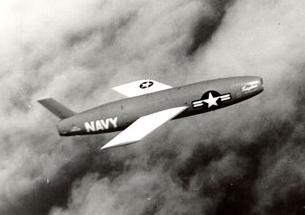Vought SSM-N-8/RGM-6 Regulus
The Regulus was the first strategic long-range nuclear-armed guided missile deployed by the U.S. Navy.
After using bomb-equipped remotely controlled target drones to strike heavily defended targets in late 1944, the Navy's development of proper surface-to-surface missile systems began in 1946. Initially, it was planned to use a variant of the USAAF's JB-2 (a V-1 look-alike cruise) missile as a ship/submarine-launched weapon, to be designated KGW-1 Loon. However, it soon became obvious that Loon was ill-suited as a tactical weapon, and it was used instead as a research vehicle (designated KUW-1, and later LTV-N-2) to test guidance and launching principles between 1947 and 1950. The Vought company was originally tasked to develop a short-range SSM, but Vought instead proposed a 320 km (200 mile) range missile, which was accepted by the Navy. In June 1946 the Navy awarded Vought a contract to develop the SSM-8 (changed to SSM-N-8 in early 1948) Regulus guided missile.
The Regulus was a turbojet-powered cruise missile, which could be launched by solid-rocket boosters from surface ships or surfaced submarines. It used a radio-command guidance system, and the missile was remotely-controlled for the whole flight by ground stations, aircraft, or ships along the flight-path. The usual procedure for a maximum range flight was that control was handed over from one controller to the next up to 3 times.
The XSSM-N-8 Regulus flight test vehicles had a retractable landing gear to make the missile reusable. The first flight of an XSSM-N-8 occurred in March 1951, the first shipboard launch succeeded in November 1952, and the first submarine launch was done in July 1953 by the USS Tunny. At about the same time, the SSM-N-8 Regulus was renamed as Regulus I, to distinguish it from the forthcoming SSM-N-9/RGM-15 Regulus II.
 |
| Photo: Vought |
| SSM-N-8 (RGM-6A) |
In May 1954, the Regulus I was declared operational. The tactical missiles, designated SSM-N-8a, were of course not equipped with a landing gear, the space being used for additional fuel. A visible difference between the SSM-N-8 and the SSM-N-8a was the slightly bulged chin of the SSM-N-8a, which was necessary to provide a common warhead section for the W-5 and W-27 nuclear warheads. By 1957, 16 ships (10 Essex-class carriers, 4 destroyers, and 2 submarines) were equipped to launch the Regulus. Additionally, many more submarines were equipped with Regulus guidance equipment.
Landing gear equipped Regulus rounds continued to be used as training missiles and target drones, with the designations SSM-N-8 (training) and KDU-1 (target).
 |
 | |
| Photo: Vought | Photo: U.S. Navy | |
| SSM-N-8a (RGM-6B) | KDU-1 (BQM-6C) |
The Regulus I had severe inherent shortcomings. A launching submarine had to surface and sit dead in the water, the guidance method was very susceptible to electronic jamming, and the missile itself flew at subsonic speeds, making interception relatively easy. In 1960, Regulus I was no longer used on carriers (it had never been popular, being regarded as a competitor to manned aircraft), but the submarine force had increased to five ships. However, at that time the UGM-27 Polaris SLBM (Submarine-Launched Ballistic Missile) system became operational, which rendered the Regulus completely obsolete.
In 1963, shortly before retirement, the Regulus I was redesignated in the RGM-6 series as follows:
| Old Designation | New Designation |
|---|---|
| SSM-N-8 | RGM-6A |
| SSM-N-8a | RGM-6B |
| KDU-1 | BQM-6C |
The last Regulus submarine was retired in 1964, and many missiles were converted into BQM-6C targets afterwards. In total, about 500 Regulus I missiles of all types were built.
Specifications
Note: Data given by several sources show slight variations. Figures given below may therefore be inaccurate!
Data for SSM-N-8a (RGM-6B):
| Length (w/o booster) | 10.1 m (33 ft 4 in) |
| Diameter | 1.4 m (56 in) |
| Wingspan | 6.4 m (21 ft) |
| Weight (w/o booster) | 4670 kg (10300 lb); booster: 790 kg (1750 lb) |
| Speed | 960 km/h (600 mph); Mach 1.1 in terminal dive |
| Ceiling | 12200 m (40000 ft) |
| Range | 925 km (500 nm) |
| Propulsion | Cruise: Allison J33-A-18A turbojet; 20 kN (4600 lb) Booster: 2x Aerojet General solid-fueled rocket; 146 kN (33000 lb) each |
| Warhead | W-5 nuclear fission (40 kT); optional W-27 thermonuclear (2 MT) warhead available from 1958 |
Main Sources
[1] Norman Friedman: "US Naval Weapons", Conway Maritime Press, 1983
[2] Bill Gunston: "The Illustrated Encyclopedia of Rockets and Missiles", Salamander Books Ltd, 1979
[3] James N. Gibson: "Nuclear Weapons of the United States", Schiffer Publishing Ltd, 1996
[4] Vought Heritage Website
Back to Current Designations Of U.S. Unmanned Military Aerospace Vehicles
Back to Directory of U.S. Military Rockets and Missiles
Last Updated: 6 January 2003